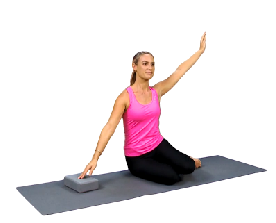Foundations first: your core and pelvic floor
Your pelvic floor and core muscles are like the foundations of a building. Without sound integrity the building will collapse. The pelvic floor is imperative for bladder and bowel control. These muscles also work with the deep abdominal and back (core) muscles to help support and stabilize your spine.
It is no surprise that these muscle groups have been stretched and weakened during pregnancy and delivery. It is important that you attend to the recovery and control of these muscles before progressing your exercise routine and that they are always strong enough to support any exercise you are performing.
Core Stabilizing Muscles
Your deepest abdominal and back muscles work like an internal muscular corset to support your spine and pelvis. Train these muscles initially on their own and later progress to more challenging core exercises.
Engage your core
You can practice engaging your core in any position. Initially you may like to try standing, kneeling, sitting or lying on your side.
Place your hand on your lower abdomen, below your naval. In under your hand runs the deep abdominals which connect with internal back muscles to create a deep, supportive muscular belt.
Breathing naturally, lengthen your spine and relax your shoulders downwards.
Gently draw your lower abdomen towards your lower back, as though drawing your lower abdomen away from your hand. Continue natural breathing and avoid bracing or tightly “sucking in” in your waist. Unlike the outer abdominals, which you can feel and see, these deep muscles are out of sight and the feeling is very subtle, like you are tightening a deep belt just one notch.
If you feel your pelvic floor lift this is indicating you are working the area well, as the muscles work together.
Hold this core recruitment for 3 breaths or longer and repeat 5 – 10 times.
Recruit your deep abdominals in this way before any exercise and practice switching on your core frequently throughout the day.
Once you have sound PF and core strength and control you can progress to other gentle exercises, but avoid any exercises where you find yourself straining or you feel you lose your pelvic floor or core and control. Remember to listen to your body and focus on quality core and pelvic floor recruitment before progressing to other strength moves.

